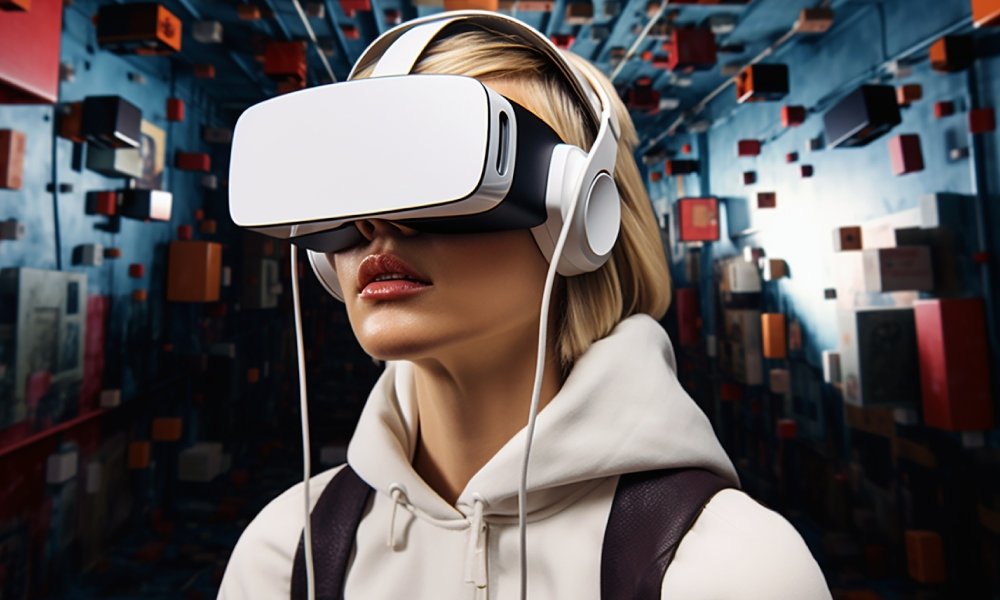Virtual Reality (VR) has long been a part of science fiction, but in recent years, it has transformed from a futuristic concept into a growing part of our reality. VR technology has revolutionized various industries, and entertainment is at the forefront of this change. From gaming to movies, concerts, and even theme park experiences, VR is poised to take us to new heights of immersion. In this post, we’ll explore how VR is shaping the future of entertainment and the exciting potential it holds.
1. VR in Gaming: A New Frontier for Interactive Entertainment
For years, the gaming industry has been one of the most obvious places where VR could make a significant impact. Today, it’s not just a possibility—it’s happening. VR gaming offers a completely immersive experience that traditional gaming platforms can’t match. Instead of just controlling a character from the outside, players can now step inside the game world and experience it as if they’re truly part of it.
What’s Changing in VR Gaming?
- Immersive Gameplay: VR headsets, like the Oculus Quest 2 and PlayStation VR, allow gamers to physically interact with the game world, creating a deeper connection and more engaging experience.
- 360-Degree Environments: Unlike flat screens, VR gaming puts players in 360-degree environments, making everything—from dodging obstacles to exploring virtual landscapes—feel incredibly real.
- Social Interaction: Games like Rec Room and VRChat are pushing the boundaries of social VR gaming, allowing players to meet, chat, and play together in virtual spaces, replicating the feel of socializing in real life.
As VR technology continues to advance, the gaming experience will only become more immersive. Future VR games may incorporate haptic feedback, allowing players to feel the virtual world in even more tangible ways, and more realistic AI could create a more dynamic and responsive gaming environment.
2. Virtual Concerts and Live Performances: The Future of Entertainment Events
The COVID-19 pandemic accelerated the trend of virtual events, but even as the world opens back up, virtual concerts and live performances remain an exciting part of the entertainment landscape. VR offers fans the chance to attend live concerts from their homes, allowing them to feel like they’re standing in the crowd, despite being miles away.
What’s Changing in Virtual Concerts?
- Live VR Music Experiences: Artists like Travis Scott and The Weeknd have already embraced VR and immersive experiences in virtual concert formats. For example, Travis Scott’s Fortnite concert allowed millions of fans to attend a spectacular virtual show in the game, blurring the lines between gaming and live music.
- 360-Degree Viewing: Fans can now enjoy concerts in VR where they’re not just watching from the front row—they can move around the virtual venue and get a 360-degree view of the performance, making the experience more interactive and dynamic.
- Virtual Festivals: VR platforms like Wave and NextVR are working on bringing festivals into the virtual space, allowing fans from all over the world to experience music, art, and performances in a completely new way.
3. Immersive Movies and Storytelling: Experiencing Films Like Never Before
VR is not only transforming how we interact with games and concerts, but it’s also changing the way we experience movies. With VR headsets, viewers can step into a movie and interact with the environment and characters. This shift is opening up entirely new possibilities for storytelling.
What’s Changing in VR Movies?
- Interactive Films: Imagine watching a movie where you can control the outcome or even interact with the characters. Movies like The Invisible Man and Star Wars: Vader Immortal have begun to explore interactive VR storytelling, where viewers can participate and make decisions that impact the narrative.
- Immersive Cinematic Worlds: Some VR experiences are less like traditional films and more like fully immersive worlds. For example, The Walking Dead: Saints & Sinners lets players explore and survive in a VR version of the hit show’s universe, creating a fully immersive storytelling experience.
- 360-Degree Cinema: Filmmakers are experimenting with 360-degree cameras to create movies and documentaries that surround the viewer with action from every angle. This format offers an entirely different kind of cinematic experience that puts the viewer right in the heart of the story.
As VR technology continues to evolve, filmmakers may create more sophisticated immersive films where the boundary between the audience and the story blurs even further.
4. Virtual Theme Parks: Step into a New World of Adventure
For years, theme parks have been a staple of family entertainment. But now, VR is bringing the thrill of roller coasters, water rides, and interactive adventures into the digital space. Virtual theme parks are starting to emerge, allowing visitors to experience all the excitement of a physical park without leaving their homes.
What’s Changing in Virtual Theme Parks?
- VR Roller Coasters: Some theme parks, like Six Flags and Disneyland, are integrating VR headsets into traditional roller coasters to provide more immersive experiences. Riders can now feel like they’re flying through space or battling robots, all while on a regular coaster track.
- Virtual Reality Rides: Instead of simply watching a screen, visitors to VR theme parks can actively participate in thrilling adventures, like chasing dragons or solving mysteries, using VR technology to enhance their experience.
- Digital Exploration: VR offers theme parks the opportunity to create virtual replicas of their attractions, allowing users to explore the park remotely. For example, VR can replicate the magic of Disney World, letting fans virtually tour iconic rides like Space Mountain and Pirates of the Caribbean.
5. The Rise of Social VR and Virtual Worlds
As VR becomes more accessible, social VR platforms are gaining popularity. These virtual worlds allow users to socialize, attend events, explore virtual spaces, and even build their own environments. VR is transforming the way we interact with friends and strangers, making online socializing more immersive and fun.
What’s Changing in Social VR?
- Virtual Social Platforms: VR platforms like Horizon Worlds by Facebook (Meta) and AltspaceVR allow users to create avatars and socialize in virtual environments. These platforms are expanding beyond just gaming to become spaces where people can attend live events, hold meetings, or just hang out with friends.
- Virtual Shopping and Socializing: Social VR experiences are also incorporating virtual shopping and events. For example, Decentraland is a virtual world where users can buy digital real estate, attend virtual concerts, and interact with brands in innovative ways.
- Work and Play in VR: As the virtual world expands, VR is also becoming a tool for remote work, allowing people to attend meetings or collaborate on projects in a more immersive way than video conferencing. Virtual coworking spaces and collaborative environments are growing in popularity.
6. The Future of VR Technology: What’s Next?
As the VR industry continues to advance, we can expect the technology to become more sophisticated and accessible. Improvements in hardware, software, and connectivity will likely lead to even more exciting possibilities for the entertainment industry.
What’s on the Horizon?
- Improved Graphics and Realism: Future VR systems will offer higher resolution, more lifelike environments, and improved motion tracking, making virtual experiences feel even more realistic.
- Haptic Feedback: VR accessories like haptic gloves and suits are in development to provide tactile feedback, allowing users to “feel” what’s happening in the virtual world, from the texture of objects to the sensation of physical movement.
- AR and VR Integration: The line between Augmented Reality (AR) and VR is beginning to blur. In the future, we may see more immersive experiences that combine both technologies, allowing users to interact with the real world while also experiencing virtual elements.
Conclusion: A New Era of Entertainment
Virtual Reality is transforming the entertainment industry by providing users with immersive, interactive experiences that were once only possible in our imaginations. Whether it’s through gaming, virtual concerts, immersive movies, or social VR worlds, the potential for VR in entertainment is limitless. As the technology continues to improve, the way we experience and interact with entertainment will only become more exciting and dynamic, ushering in a new era of creativity and innovation.




No Comment! Be the first one.